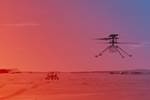AeroVironment celebrates composite-intensive Ingenuity Helicopter flight on Mars
The AeroVironment team played a key role in developing the helicopter’s carbon fiber airframe and major subsystems.

AeroVironment Mars Ingenuity Helicopter Program team members Sara Langberg, Peter Zwaan, Joey Beckman, Ben Pipenberg, Jeremy Tyler and Matt Keennon celebrate Ingenuity’s successful first flight. Photo Credit: AeroVironment Inc.
AeroVironment Inc. (Simi Valley, Calif., U.S.) an unmanned aircraft systems (UAS) company, celebrated with its colleagues at NASA/JPL on April 21 when data confirming the Ingenuity Helicopter’s successful first flight on Mars arrived at approximately 3:50 a.m. PT on April 19. Since 2013, the AeroVironment team has worked closely with NASA rotorcraft experts and with JPL electrical, mechanical, materials, vehicle flight controls and systems engineers on the Mars Ingenuity Helicopter project.
“AeroVironment is proud to have played a key role in developing the Mars Ingenuity Helicopter and achieving this historic first powered flight on another planet,” says Wahid Nawabi, AeroVironment president and CEO. “We congratulate JPL and NASA on the achievement and salute their leadership and vision for deploying unmanned technology to further our understanding of other worlds.”
AeroVironment’s contributions to Ingenuity include the design and development of the helicopter’s airframe and major subsystems, including its rotor, rotor blades, hub and control mechanism hardware; the company used Toray Advanced Composites’ (Morgan Hill, Calif., U.S.) carbon fiber prepreg materials for the helicopter’s structure and rotor blades. AeroVironment also developed and built high-efficiency, lightweight propulsion motors, power electronics, landing gear, load-bearing structures and the thermal enclosure for NASA/JPL’s avionics, sensors and software systems.
“AeroVironment’s deep, rich and diverse history of designing reliable and effective unmanned solutions that deliver mission success in extreme environments, combined with our experience with near-space aircraft, make us uniquely suited to collaborate with NASA and JPL,” Nawabi says. “We also incorporated the ultra-lightweight and ultra-high-precision methods integral to Nano projects that have been developed in our MacCready Works Advance Solutions laboratory, where we’ve assembled a dedicated team of the industry’s brightest and most experienced engineers to solve some of today’s greatest technological challenges.”
Related Content
-
Composites manufacturing for general aviation aircraft
General aviation, certified and experimental, has increasingly embraced composites over the decades, a path further driven by leveraged innovation in materials and processes and the evolving AAM market.
-
A new era for ceramic matrix composites
CMC is expanding, with new fiber production in Europe, faster processes and higher temperature materials enabling applications for industry, hypersonics and New Space.
-
Plant tour: Albany Engineered Composites, Rochester, N.H., U.S.
Efficient, high-quality, well-controlled composites manufacturing at volume is the mantra for this 3D weaving specialist.













